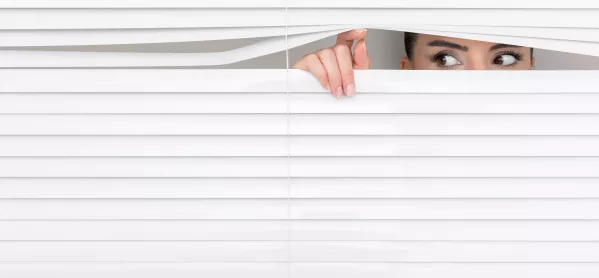My losing battle with classroom blinds

Online teaching may have had its moments of minor calamity, but there is surely nothing so publicly humiliating as being in a real classroom when the projector screen starts to play up.
When pulling down the dangling handle to unfurl the spring-loaded screen, the advised “count to five” for holding and then releasing usually works perfectly well.
But I know never to count my chickens. I breathe a quiet sigh of relief each time. I know from experience that this current happy relationship with the screen’s mechanism is not going to be a lifelong commitment.
Without warning, a day will come when it will decide that it has had enough. It will quietly sneer at my faithful counting, and squeal rapidly and repeatedly back up into its tubular home, like the rat that it basically is. Which, of course, is hugely entertaining for the young audience before me.
Yes, I know I can then improvise by fastening the handle to a willing child’s ankle, but it’s never a good look for anyone who happens to drop in.
Alternatively, the screen will suddenly refuse one day to spring cheerily back up to its home when I wish to use the whiteboard behind it. The customary pull-to-release procedure merely causes more and more of the screen to roll out from the tube. Metres of surplus screen start billowing across the floor like some cut-price wedding dress.
Does anyone know what they’re doing with classroom blinds?
Though at least these crises with the projector screen are only occasional. A related and much more common classroom headache - especially in the summer term - involves the effective deployment of all the other pull-down screens around the room.
Is anyone out there really sure what they are doing with their classroom blinds, particularly with regard to optimising both health, happiness and learning?
In earlier times, the classroom blinds were of marginal relevance. Their only real role used to be to provide shade at times of excessive heat and dazzle, as well as to give idle hands something to fidget with to help alleviate the boredom.
But blinds are so much more important in a modern classroom. So many more factors need to be taken into account. We now know that access to adequate sunlight plays a key role in maintaining good physical and mental health. And yet lessons nowadays frequently require the room to be in a darkened state for all our projector-based presentations and video clips.
And, at the moment, we also have to ensure enough throughput of fresh air.
The blind leading the blinds
How does a teacher strike the perfect balance between all these conflicting considerations? Should we be adjusting and fine-tuning our blinds constantly with that in mind? For, as one seller of classroom blinds puts it so poetically in its advertising: “Like plants, students need the right levels of light and temperature in order to grow to their full potential.”
Yet despite their fundamental importance, no one trains us in optimal usage of blinds. There’s complete silence on the matter from all the great educational thinkers past and present - from Plato to Piaget, Gove to Gibb, from Wiliam to Williamson. No one has a clue. It’s the blind leading the blinds.
We haven’t even been told whether it’s better educationally to opt for a roller or a Venetian. Years ago, someone obviously went for a now rather aged set of Venetians in the room I most commonly teach in. Despite my best efforts - once even prompting sympathetic applause - one of those blinds now remains chronically stuck in a half-up half-down condition across one set of panes.
Its diagonal coverage is never totally right, though in fairness it’s never completely wrong either. Its warped and twisted shape looms hauntingly in the corner of my eye for most of my working day, a metaphor perhaps for everything else that haphazardly unfolds in that classroom.
That said, a fully functioning Venetian is, for me, far more preferable to the rather crude roller options favoured by many more modern classrooms. The gradual coaxing down of my other fully working Venetians - a careful tug here on one cord and then on the other - is probably one of the most satisfying moments of my school day.
It may lack the robustness of the roller, but the Venetian has a bit more style and the slats give us a far greater range of options. To my mind, the roller cannot begin to offer the same degree of variation and subtlety. Far from cooling a room, some types of roller can also make some rooms unbearably hot in this summer term.
But that’s just my inexpert view. In common with most, I am just flailing in the dark.
Stephen Petty is head of humanities at Lord Williams’s School in Thame, Oxfordshire
You need a Tes subscription to read this article
Subscribe now to read this article and get other subscriber-only content:
- Unlimited access to all Tes magazine content
- Exclusive subscriber-only stories
- Award-winning email newsletters
Already a subscriber? Log in
You need a subscription to read this article
Subscribe now to read this article and get other subscriber-only content, including:
- Unlimited access to all Tes magazine content
- Exclusive subscriber-only stories
- Award-winning email newsletters